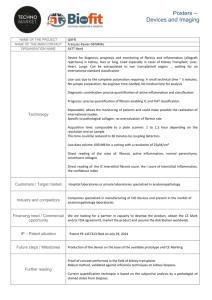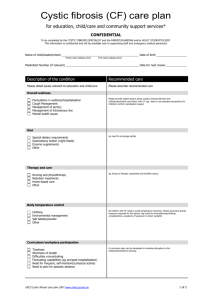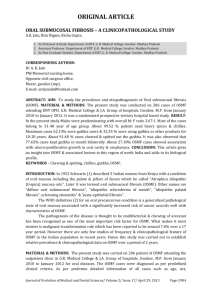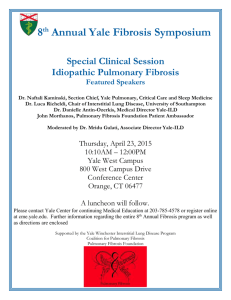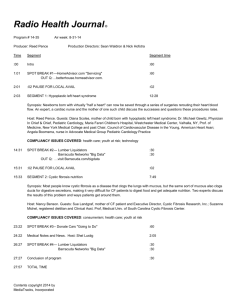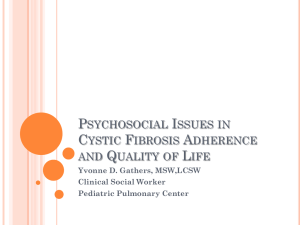Oral Sub Mucous Fibrosis (OSMF): Premalignant Threat to Humanity
advertisement
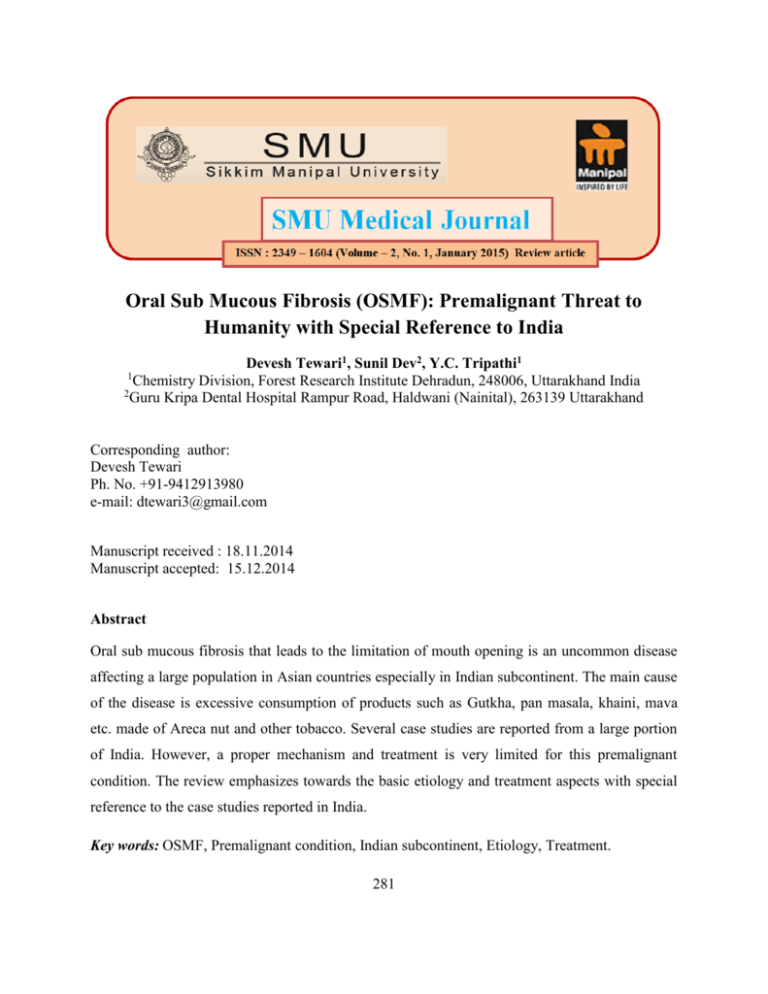
Oral Sub Mucous Fibrosis (OSMF): Premalignant Threat to Humanity with Special Reference to India Devesh Tewari1, Sunil Dev2, Y.C. Tripathi1 Chemistry Division, Forest Research Institute Dehradun, 248006, Uttarakhand India 2 Guru Kripa Dental Hospital Rampur Road, Haldwani (Nainital), 263139 Uttarakhand 1 Corresponding author: Devesh Tewari Ph. No. +91-9412913980 e-mail: dtewari3@gmail.com Manuscript received : 18.11.2014 Manuscript accepted: 15.12.2014 Abstract Oral sub mucous fibrosis that leads to the limitation of mouth opening is an uncommon disease affecting a large population in Asian countries especially in Indian subcontinent. The main cause of the disease is excessive consumption of products such as Gutkha, pan masala, khaini, mava etc. made of Areca nut and other tobacco. Several case studies are reported from a large portion of India. However, a proper mechanism and treatment is very limited for this premalignant condition. The review emphasizes towards the basic etiology and treatment aspects with special reference to the case studies reported in India. Key words: OSMF, Premalignant condition, Indian subcontinent, Etiology, Treatment. 281 SMU Medical Journal, Volume – 2, No. 1, January 2015 Introduction The consumption of Tobacco in India has been practiced from a long time. Previously the tobacco was used in the form of tobacco leaves or smoking tobacco but in the present scenario a large number of marketed products are available commercially. The tobacco and tobacco products contains about 60 carcinogens. The smokeless tobacco products are very common in India some of the tobacco products which are highly in demand are Khaini, Gutkha, Pan with tobacco, Pan masala, Toothpastes, dry snuff etc.1. In 1952, Schwartz2 described five Indian women from Kenya with a condition of the oral mucosa including the palate and pillars of the fauces, which he called "atrophia idiopathica (tropica) mucosae oris". Later it was termed oral submucous fibrosis (OSMF)3; other names are "diffuse oral submucous fibrosis", "idiopathic scleroderma of the mouth", "idiopathic palatal fibrosis", "sclerosing stomatitis" and "juxta-epithelial fibrosis4,5. Oral submucous fibrosis is a chronic insidious disease and a well recognized potentially malignant condition of the oral cavity characterized by inflammation and a progressive fibrosis of the lamina propria and deeper connective tissues. which can affect oral cavity and sometimes pharynx. Chewing Betel quid is a popular oral habit in India, and shows strong association in the incidence of oral submucous fibrosis, a premalignant condition of the oral mucosa. Although occasionally preceded by vesicle formation, it is always associated with juxtaepethelial inflammatory reaction followed by a fibroelastic change of lamina propia with epethial atrophy leading to stiffness of oral mucosa, causing trismus and inability to eat. It is a disease of unknown cause that occurs mainly in India 6, 7 . The condition predominantly seen among people of Indian origin, and an epidemiologic survey done a decade ago showed no less than 250,000 cases in India, a figure that must have increased sharply 8,9. The use of smokeless tobacco associated with oral cancer was pointed out as early as 1908. Subsequent Indian studies on tobacco have amply shown its association with major diseases entities, both in smoking as well as in smokeless form. The habit of smokeless tobacco (also referred as tobacco chewing) is also very common. Association of smokeless tobacco has been observed with cancers of oral cavity, pharynx, larynx and oesophagus, and precancerous lesions of oral cavity10, 11. Various etiologic factors such as capsaicin, betel nut alkaloids, autoimmunity, hypersensitivity, genetic predisposition, chronic iron and vitamin B-complex deficiency were suggested, the most common of which is chewing areca nut. The excessive use of areca nut may cause fibrosis due to increased synthesis of collagen and induce the production of free radicals and reactive oxygen 282 SMU Medical Journal, Volume – 2, No. 1, January 2015 species, which are responsible for high rate of oxidation/peroxidation of polyunsaturated fatty acids which affect essential constituents of cell membrane and might be involved in tumorigenesis12, 13. Areca nut chewing is deep rooted in Indian culture and has been used as a mouth freshening agent that has various symbolic roles throughout Indian history The most alarming fact is that this habit is becoming increasingly popular among adolescents12, 14. The main causative factor is Areca nut chewing which is known to cause local trauma and injury to the oral mucosa as it is an abrasive. Pan masala and gutkha users are more severely affected due to their fine particulate nature, with more particle adhesion to the traumatized mucosa, which leads to morphological changes and membrane damage. This continuous local irritation by pan masala, gutkha or areca nut can lead to injury related chronic inflammation, oxidative stress and cytokine production. Oxidative stress and subsequent Reactive oxygen species (ROS) generation can induce cell proliferation, cell senescence or apoptosis, according to the level of ROS production. These events can lead to preneoplastic lesions in the oral cavity and subsequent to malignancy in chronic use15. The occurrence rate of oral carcinoma is still increasing due to the lack of sophisticated diagnostic and therapeutic approaches16. Symptoms and clinical complications of OSMF The OSMF begins with burning sensation and/or intolerance to spicy food, vesicles. Pain on palpation in the developing site of submucosal fibrotic bands is caused mostly by fibrosis in the dense tissue around the pterygomandibular raphae. Ulceration and dryness of the mouth followed by fibrosis of the oral mucosa lead to the rigidity of lips, tongue and palate and trismus. Pathogenesis/ Aetiology of OSMF There are various factors for the pathogenesis of OSMF as iron and nutritional deficiencies, chronic candidiasis, betel quid, genetic abnormalities, tobacco, lime, Herpes simplex virus (HSV), Human papilloma virus (HPV), autoimmunity etc. have been postulated and known to have either direct effect in causing OSMF or an indirect effect by mediating the immune system which is compromised in OSMF 8. 283 SMU Medical Journal, Volume – 2, No. 1, January 2015 Areca nut Flavonoids (catechin and Tannins) Collagenase inhibition Alkaloids Long term chewing Hydrolysis of Arecoline Proliferation of fibroblast and collagen formation Muscular contracture Reduced breakdown of collagen ORAL SUBMUCOUS FIBROSIS (OSMF) Depletion of glycogen Muscle scarring and fibrosis PRONOUNCE D LIMITATION OF MOUTH OPRNING 284 SMU Medical Journal, Volume – 2, No. 1, January 2015 Two of the most important biological pathways responsible in the pathogenesis of OSMF are Collagen production pathway and Collagen degradation pathway. Collegen production pathway involves mainly there steps that is activation of procollagen, elevation of procollagen proteinase levels, and upregulation of lysyl oxidase (LOX). LOX is a copper dependent enzyme that plays a key role in collagen synthesis and cross linkage. The fibroblasts in OSMF have not only increased lysyl oxidase activities but also potentiate specific growth characteristics 17 . In collagen degradation pathway the TGF-β modulates the activation of tissue inhibitor of matrix metalloproteinase (TIMPs) and activates the plasminogen activator inhibitor gene (PAI). Saliva also plays an indirect role in OSMF. Persons affected from OSMF contains fibrin production factor in their saliva. Fibrin production factor interacts with the fibrogen or plasma present in the oral cavity and produce dens fibrosis7. There are some fundamental culprits of OSMF like consumption of excessive chillies as the main chemical constituent capsasin is mainly responsible and play an important role. Presence of autoimmune role and genetic predisposition. Deficiency of various minerals and vitamins and the most important etiological factor in OSMF Areca nut which is an endosperm of the Areca catechu Palm tree fruit. It was found that the onset of the disease is directly proportional to the concentration and duration of chewing the nut 18, 19. Oral Submucous fibrosis in India There are some case reports available of the OSMF from Punjab, Uttar Pradesh and the disease is said to be one of the most poorly understood and unsatisfactorily treated disease20. Another study was carried out in Indore, Madhya Pradesh in 390 OSMF subjects and reported that the consumption of commercially available areca nut and tobacco byproducts showed a higher severity in terms of clinical grading. It was also reported that as habit variables in the form of duration, frequency, and chewing for longer duration and swallowing without spitting have increased its significance in correlation to severity of clinical grading21. A total of 157 OSMF cases were studied in Patana Bihar and the youngest reported case of 11 year old is an alarming situation22. It was also reported that chewing habit is caused by tobacco, which initially triggers 285 SMU Medical Journal, Volume – 2, No. 1, January 2015 histophysiological and histopathological changes and leads to OSMF in susceptible individuals and gutkha chewing was preferred by younger people (i.e., 11-30 years)22. In Aligarh 58 patients of OSMF were studied and observed the partial response to treatment and reported the disease with malignant potential and the prevention was suggested to prohibit the use of Guthkha, pan masala23. A study reported from Rajasthan indicated the prevalence of OSMF and use of smokeless tobacco and it was also reported that it was rising in the younger age group 24. Areca nut, Guthakha and other such commercial products showed the relation with OSMF in Hydarabad, Delhi 25, 26 . The socioeconomic status was also related with OSMF and it was reported that most of the people with OSMF were of low socioeconomic group27. Asian community settled in United Kingdom showed the presence of the OSMF patients from low or middle-income group28 Management of OSMF The management of the patients of OSMF is generally carried out either by medical or surgical management. There is a very limited number of formulations available specifically for the treatment of OSMF however some pharmaceutical companies are providing antioxidant related compounds for the management of OSMF. Steroids may also be used in the management of moderate OSMF29. Apart from these placental extract, Hyaluridase, IFN-gamma are also attributed in the management of OSMF30-32. The surgical management of OSMF is carried out in the patients of severe conditions. Surgical managements include simple excision of the fibrous bands, it can result in contracture of the tissue and exacerbation of the condition, skin grafts may pose relieve in the condition, the patients whose tongue is not involved Nasolabial flaps and lingual pedicle flaps surgery performed33-35. Conclusion The review of the status of the uncommon disease with premalignant properties concluded that there is a dangerous situation specially in India regarding oral submucous fibrosis. Various studies clearly suggested the potential harm to the oral mucosa by various smokeless tobacco products especially in combination with areca nut. The use of Areca nut should be avoided in 286 SMU Medical Journal, Volume – 2, No. 1, January 2015 commercial smokeless tobacco products. It is an urgent need to educate people about the adverse effects regarding oral cavity, however there is crucial steps were also been taken by the Supreme court, Government of India and other state governments by placing ban on such commercial products still there are several local or branded manufacturers who are sailing such products with different names or in different formulation type. The researchers should evolved to unexplored the clear mechanism behind the OSMF and its treatment further the work is also required in the field of drug designing and for neutralizing the effects of Areca nut a nature base therapy could be develop. References 1. Tobacco use in India: An evil with many faces. Distributed by Cancer patients Aid Association Total management of Cancer. India Cancer Initiative, American Cancer Society, p 1-7, 2009. 2. Schwartz J. Atrophia Idiopathica (tropica) mucosae oris. Demonstrated at the Eleventh International Dental Congress, London, 1952 (cited by Sirsat & Khanolkar). Indian Journal of Medical Science, 16, 189-197, 1962. 3. Joshi SG. Submucous fibrosis of the palate and pillars. Indian Journal of Otolaryngol., 4, 1-4, 1953. 4. Pindborg JJ, Sirsat SM. Oral submucous fibrosis. Oral Surgery, Oral Medicine, Oral Pathology and Endodontology, 22, 764-779, 1966. 5. Rajendran R. Oral submucous fibrosis: etiology, pathogenesis and future research. Bulletin of the World Health Organization, 72 (6), 985-996, 1994. 6. Singh L, Bharti SS, Sudhapalli S, Chopra D, Srivastava V. International Journal of Clinical and Dental Science, 2(4), 29-35, 2011. 7. Sudarshan R, Annigeri RG, Sree VG. Pathogenesis of oral submucous fibrosis: The past and current concept. International Journal of Oral and Maxillofacial Pathology, 3(2), 2736, 2012. 8. Pillai R, Balram P, Reddiar KS. Pathogenesis of oral submucous fibrosis: Relationship to risk factors associated with oral cancer. Cancer, 69, 2011-2020, 1992. 287 SMU Medical Journal, Volume – 2, No. 1, January 2015 9. Auluck A, Rosin MP, Zhang L, Sumanth KN. Oral Submucous Fibrosis, a Clinically Benign but Potentially Malignant Disease: Report of 3 Cases and Review of the Literature. Journal of Canadian Dental Association, 74(8), 735-740, 2008. 10. Niblock WJ. Cancer in India. Indian Medical Gazette, 37, 161-165, 1902. 11. Bhonsle RB, Murti PR, and Gupta PC. Tobacco habits in India. In: Gupta PC, & Hamner JE III (eds.), Control of tobacco related cancers and other diseases. International Symposium, 1990. Oxford University Press, Bombay, p 25-46, 1992. 12. Selvam NP and Dayanand AA. Lycopine in the management of oral submucous fibrosis. Asian Journal of Pharmaceutical and Clinical Research, 6(3), 58-61, 2013. 13. Chole RH, Shailesh M. Gondivkar, Amol R. Gadbail, Swati Balsaraf, Sudesh Chaudhary, Snehal V. Dhore et al. Review of drug treatment for oral submucous fibrosis. Oral Oncology, 48, 393-398, 2012. 14. Kumar A, Bagewadi A, Keluskar V, Singh M. Efficacy of lycopene in the management of oral submucous fibrosis. Oral Surgery, Oral Medicine, Oral Pathology and Endodontology, 103, 207-213, 2007. 15. Nair U, Bartsch H, Nair J. Alert for an epidemic of oral cancer due to use of the betel quid substitutes gutkha and pan masala: a review of agents and causative mechanisms. Mutagenesis, 19, 251-262, 2004. 16. Chitra S, Bal;asubramanianm M and Hazara J. Effect of α-tocopherol on salivary reactive oxygen species and trace elements in oral submucous fibrosis. Annals of Clinical Biochemistry, 49, 262-265, 2012. 17. Dyavanagoudar SN. Oral Submucous Fibrosis: Review on Etiopathogenesis. Journal of Cancer Science and Therapy, 1, 72-77, 2009. 18. Arakeri G and Burnnan PA. Oral submucous fibrosis: an overview of the aetiology, pathogenesis, classification and principles of management. British Jornal of Oral and Maxillofacial Surgery , 51(7), 587-593, 2013. 19. Lu, R., Dan, H., Wu, R., Meng, W., Liu, N., Jin, X., Zhou, M., Zeng, X., Zhou, G. and Chen, Q. Lycopene: features and potential significance in the oral cancer and precancerous lesions. Journal of Oral Pathology & Medicine, 40, 361-368, 2011. 288 SMU Medical Journal, Volume – 2, No. 1, January 2015 20. Chopra A, Sethi P S, Singh J, Dimple. Oral submucous fibrosis (OSMF). Indian Journal of Dermatology, Venereology and Leprology, 66, 255-256, 2000. 21. Reddy V, Wanjari PV, Banda NR, Reddy P. Oral submucous fibrosis: correlation of clinical grading to various habit factors. International Journal of Dental Clinics, 3(1), 2124, 2011. 22. Ahmad MS, Ali SA, Ali AS, Chaubey KK. Epidemiological and etiological study of oral submucous fibrosis among gutkha chewers of Patna, Bihar, India. Journal of Indian Society of Pedodontics and Preventive Dentistry, 24, 84-89, 2006. 23. Afroz N, Hasan SA, Naseem S. Oral Submucous Fibrosis A Distressing Disease with Malignant Potential. Indian Journal of Community Medicine, 31(4), 270-271, 2006. 24. Sharma R, Raj SS, Miahra G, Reddy YG, Shenava S, Narang P. Prevalence of oral Submucous fibrosis in patients visiting Dental college in Rural area of Jaipur, Rajasthan. Journal of Indian Academy of Oral Medicine & Radiology, 24(1), 1-4, 2012. 25. Babu S, Bhat RV, Kumar PU, Sesikaran B, Rao KV, Aruna P, et al. A comparative clinico-pathological study of oral submucous fibrosis in habitual chewers of panmasala and betel quid. Clinical Toxicology, 34, 317-322, 1996. 26. Shah N, Sharma PP. Role of chewing and smoking habits in the etiology of oral submucous fibrosis: A case control study. Journal of Oral Pathology & Medicine, 27: 475-479, 1998 27. Ramanathan K. OSMF-An alternative hypothesis as to its causes. Medical Journal of Malaysia, 36, 243-245, 1981. 28. McGurg M, Craig GT. OSMF: Two Cases of Malignant Transformation in Asian Immigrants to the United Kingdom British Jornal of Oral and Maxillofacial Surgery, 22, 56-64, 1984. 29. Aziz SR. Oral submucous fibrosis: an unusual disease. Journal of the New Jersey Dental Association, 68, 17-19, 1997. 30. Haque MF, Meghji S, Khitab U, Harris M . Oral submucous fibrosis patients have altered levels of cytokine production. Journal of Oral Pathology & Medicine, 29(3), 123-128, 2000. 289 SMU Medical Journal, Volume – 2, No. 1, January 2015 31. Kakar PK, Puri RK, Venkatachalam VP. Oral submucous fibrosis—treatment with hyalase. Journal of Laryngology and Otology, 99(1), 57-69, 1985. 32. Sur TK, Biswas TK, Ali L, Mukherjee B. Anti-inflammatory and anti-platelet aggregation activity of human placental extract. Acta Pharmacologia Sinica, 24(2), 187192, 2003. 33. Caniff JP, Harvey W, Harris M. Oral submucous fibrosis: its pathogenesis and management. British Dental Journal, 160, 429-434, 1986. 34. Hosein M. Oral cancer in Pakistan. The problem and can we reduce it? In: Oral Oncology. Kluwer Academic, 1994. 35. Sabharwal R, Gupta S, Kapoor K, Puri A, Rajpal K. Oral Submucous Fibrosis- A Review. Journal of Advanced Medical and Dental Sciences Research, 1(1), 29-37, 2013. Authors Column Devesh Tewari is a Post Graduate in Pharmaceutical Sciences and pursuing his Ph.D. research at Kumaun University Nainital, Uttarakhand, India. Sri Tewari conducted his dissertation from Defence Institute of BioEnergy Research, DRDO. He is currently working as Research Fellow at Chemistry Division Forest Research Institute, Dehradun, India. Sri Tewari worked as Assistant Professor (Pharmaceutical Sciences) for one and half year. He has received Young Scientist Award from the Science and Technology Council, Government of Uttarakhand. Sri Tewari has published research papers in various peer reviewed national and international journals and has delivered various lectures as presenter, resource person in the area of Natural Product Research and phytopharmacology. He is life member of Indian Science Congress Association and other scientific bodies. SMU Medical Journal, Volume – 2, No. – 1 , January, 2015, PP. 281 – 290. © SMU Medical Journal
